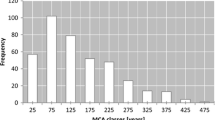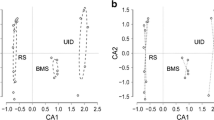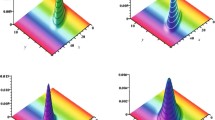Abstract
Tree structural diversity is assessed by modelling stand diameter at breast height (DBH) distribution. The aim of this study was to verify the suitability of a mixture of two- and three-component Weibull and gamma models for describing irregular and multimodal DBH distributions. Investigations were carried out in natural Abies alba Mill. and Fagus sylvatica L. stands, representing the growing-up stage, in the Świętokrzyski National Park (Central Poland) and in the Pieniny National Park (Southern Poland). Sample plots (0.25–0.5 ha in area) were selected from a database used for forest dynamics analysis. The parameters of the mixture model were estimated using maximum likelihood estimation (MLE) and a combination of an expectation–maximisation (EM) algorithm with a Newton-type (NT) method. The multistart method (MM) of choosing initial values was used. The DBH distributions in mixed Abies–Fagus forests of complex structure were accurately approximated by two- and three-component mixture models. The root mean square error (RMSE) values varied from 3.4515 to 7.6682 for the Weibull mixture and from 3.6457 to 7.1419 for the gamma mixture. The results indicated that the mixture Weibull and gamma models were, in general, equally suitable for modelling irregular and multimodal DBH distributions. Finite mixture models may be used to characterise tree structural diversity, especially in uneven-aged stands of complex structure.







Similar content being viewed by others
References
Arora JS, Elwakeil OA, Chahande AI, Hsieh CC (1995) Global optimization methods for engineering applications: a review. Struct Optim 9:137–159
Böhning D (2000) Computer-assisted analysis of mixtures and applications. Chapman & Hall/CRC, Boca Raton
Du J (2002) Combined algorithms for fitting finite mixture distributions (unpublished M.Sc. project). McMaster University, Hamilton
FAO, ISRIC, ISSS (2006) World reference base for soil resources (World Soil Resources Reports no. 103). FAO, Rome
Goelz JCG, Leduc DJ (2002) A model describing growth and development of longleaf pine plantations: consequences of observed stand structures of structure of the model (Gen Tech Rep SRS-48). US Department of Agriculture, Forest Service, Southern Research Station, Asheville, pp 438–442
Goff FG, West D (1975) Canopy–understory interaction effects on forest population structure. For Sci 21:98–108
Hessenmoller D, von Gadow K (2001) Beschreibung der Durchmesserverteilung von Buchenbeständen mit Hilfe der bimodalen weibullfunktion. Allg Forst- und Jagdzeitung 172:46–50
Inoue S, Shirota T, Mitsuda Y, Ishii H, Gyokusen K (2008) Effects of individual size, local competition and canopy closure on the stem volume growth in a monoclonal Japanese cedar (Cryptomeria japonica D. Don) plantation. Ecol Res 23:953–964
Jang W, Park PS (2010) Stand structure and maintenance of Picea jezoensis in a northern temperate forest, South Korea. J Plant Biol 53:180–189
Jaworski A (1997) Karpackie lasy o charakterze pierwotnym i ich znaczenie w kształtowaniu proekologicznego modelu gospodarki leśnej w górach. Sylwan 141:33–49
Jaworski A, Podlaski R (2006) Budowa, struktura i dynamika drzewostanów naturalnych w rezerwacie Święty Krzyż (Świętokrzyski Park Narodowy). Acta Agr Silv ser Silv 44:9–38
Jaworski A, Podlaski R (2007) Structure and dynamics of selected stands of primeval character in the Pieniny National Park. Dendrobiology 58:25–42
Jaworski A, Paluch J, Pach M, Kołodziej Z, Majerczyk K (2007) Charakterystyka lasów przerębowych w wybranych nadleśnictwach Regionalnej Dyrekcji Lasów Państwowych w Krakowie. Sylwan 151:34–52
Korpel’ Š (1995) Die Urwälder der Westkarpaten. G Fischer-Verlag, Stuttgart
Král K, Vrška T, Hort L, Adam D, Šamonil P (2010) Developmental phases in a temperate natural spruce-fir-beech forest: determination by a supervised classification method. Eur J For Res 129:339–351
Liu C, Zhang L, Davis CJ, Solomon DS, Grove JH (2002) A finite mixture model for characterizing the diameter distribution of mixed-species forest stands. For Sci 48:653–661
Liu C, Beaulieu J, Prégent G, Zhang SY (2009) Applications and comparison of six methods for predicting parameters of the Weibull function in unthinned Picea glauca plantations. Scand J For Res 24:67–75
Macdonald PDM, Du J (2004) mixdist: mixture distribution models. R package version 0.5-1. http://www.r-project.org, http://www.math.mcmaster.ca/peter/mix/mix.html
Macdonald PDM, Pitcher TJ (1979) Age-groups from size-frequency data: a versatile and efficient method of analyzing distribution mixtures. J Fish Res Board Can 36:987–1001
McLachlan G, Krishnan T (2008) The EM algorithm and extensions. Wiley, Hoboken
McLachlan G, Peel D (2000) Finite mixture models. Wiley, New York
Maltamo M, Kangas A (1998) Methods based on k-nearest neighbor regression in estimation of basal area diameter distribution. Can J For Res 28:1107–1115
Matuszkiewicz JM (2008) Zespoły leśne Polski. Państwowe Wydawnictwo Naukowe, Warszawa
Merganič J, Sterba H (2006) Characterisation of diameter distribution using the Weibull function: method of moments. Eur J For Res 125:427–439
Nagel TA, Svoboda M, Diaci J (2006) Regeneration patterns after intermediate wind disturbance in an old-growth Fagus-Abies forest in southeastern Slovenia. For Ecol Manag 226:268–278
Oliver CD, Larson BC (1996) Forest stand dynamics. Wiley, New York
Olszewski JL, Szałach G, Żarnowiecki G (2000) Klimat. In: Cieśliński S, Kowalkowski A (eds) Świętokrzyski Park Narodowy. Przyroda, Gospodarka, Kultura. Świętokrzyski Park Narodowy, Bodzentyn, pp 129–145
Perzanowska J (2004) Klimat Pienin. Stud Nat 49:21–32
Piovesan G, Di Filippo A, Alessandrini A, Biondi F, Schirone B (2005) Structure, dynamics and dendroecology of an old-growth Fagus forest in the Apennines. J Veg Sci 16:13–28
Podlaski R (2006) Suitability of the selected statistical distributions for fitting diameter data in distinguished development stages and phases of near-natural mixed forests in the Świętokrzyski National Park (Poland). For Ecol Manag 236:393–402
Podlaski R (2008a) Dynamics in Central European near-natural Abies–Fagus forests: does the mosaic-cycle approach provide an appropriate model? J Veg Sci 19:173–182
Podlaski R (2008b) Characterization of diameter distribution data in near-natural forests using the Birnbaum–Saunders distribution. Can J For Res 38:518–527
Podlaski R (2010) Diversity of patch structure in Central European forests: are tree diameter distributions in near-natural multilayered Abies–Fagus stands heterogeneous? Ecol Res 25:599–608
Podlaski R, Zasada M (2008) Comparison of selected statistical distributions for modelling the diameter distributions in near-natural Abies-Fagus forests in the Świętokrzyski National Park (Poland). Eur J For Res 127:455–463
Pretzsch H (1997) Analysis and modelling of spatial stand structures. Methodological considerations based on mixed beech-larch stands in Lower Saxony. For Ecol Manag 97:237–253
Pretzsch H (2001) Models for pure and mixed forests. In: Evans J (ed) The forests handbook. Blackwell Science, London, pp 210–228
R Development Core Team (2008) R: a language and environment for statistical computing. R Foundation for Statistical Computing, Vienna. ISBN 3-900051-07-0, http://www.R-project.org
Reynolds MR, Burk T, Huang WH (1988) Goodness-of-fit tests and model selection procedures for diameter distribution models. For Sci 34:373–399
Rubin BD, Manion PD, Faber-Langendoen D (2006) Diameter distributions and structural sustainability forests. For Ecol Manag 222:427–438
Runkle JR (1985) Disturbance regimes in temperate forests. In: Pickett STA, White P (eds) The ecology of natural disturbance and patch dynamics. Academic, Orlando, pp 17–33
Scrinzi G, Marzullo L, Galvagni D (2007) Development of a neural network model to update forest distribution data for managed alpine stands. Ecol Model 206:331–346
Shimano K (2000) A power function for forest structure and regeneration pattern of pioneer and climax species in patch mosaic forests. Plant Ecol 146:207–220
Shimatani K, Satoko Kawarasaki S, Manabe T (2008) Describing size-related mortality and size distribution by nonparametric estimation and model selection using the Akaike Bayesian information criterion. Ecol Res 23:289–297
Wang S, Dai L, Liu G, Yuan J, Zhang H, Wang Q (2006) Modeling diameter distribution of the broadleaved-Korean pine mixed forest on Changbai Mountains of China. Sci China Ser E-Tech Sci 49:177–188
Wolfram S (2003) The Mathematica book, 5th edn. Wolfram Media/Cambridge University Press, Cambridge
Zasada M, Cieszewski CJ (2005) A finite mixture distribution approach for characterizing tree diameter distributions by natural social class in pure even-aged Scots pine stands in Poland. For Ecol Manag 204:145–158
Zhang LJ, Liu C (2001) Use of a finite mixture model in describing irregular diameter distributions of forest stands. In: LeMay V, Marshall P (eds) Proceedings of IUFRO Conference on Forest Modelling for Ecosystem Management. Forest Certification and Sustainable Management. Faculty of Forestry, University of British Columbia, Vancouver, pp 451–461
Zhang LJ, Liu C (2006) Fitting irregular diameter distributions of forest stands by Weibull, modified Weibull, and mixture Weibull models. J For Res 11:369–372
Zhang LJ, Gove JH, Liu C, Leak WB (2001) A finite mixture of two Weibull distributions for modeling the diameter distributions of rotated-sigmoid, uneven-aged stands. Can J For Res 31:1654–1659
Acknowledgments
We are indebted to Professor Peter D.M. Macdonald from the Department of Mathematics and Statistics, McMaster University, Canada, for making the mixdist package available. We are also indebted to K. McCay for improving the English of this manuscript.
Author information
Authors and Affiliations
Corresponding author
About this article
Cite this article
Jaworski, A., Podlaski, R. Modelling irregular and multimodal tree diameter distributions by finite mixture models: an approach to stand structure characterisation. J For Res 17, 79–88 (2012). https://doi.org/10.1007/s10310-011-0254-9
Received:
Accepted:
Published:
Issue Date:
DOI: https://doi.org/10.1007/s10310-011-0254-9




